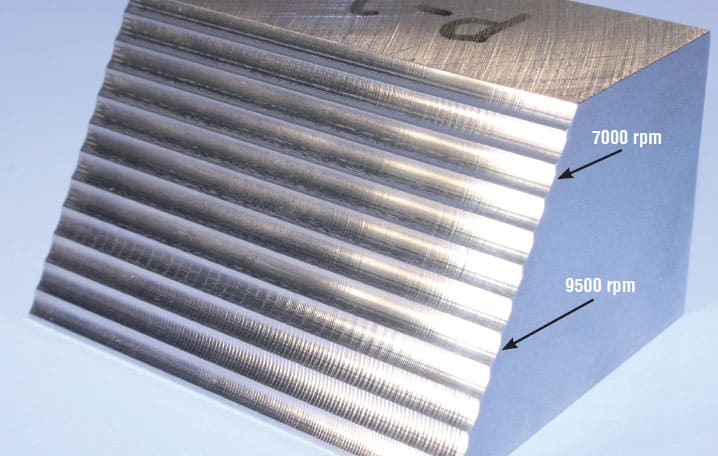CNC Router Process Optimisation with ST IO-Link Solutions Part 1: Introduction
Follow articleHow do you feel about this article? Help us to provide better content for you.
Thank you! Your feedback has been received.
There was a problem submitting your feedback, please try again later.
What do you think of this article?
Retrofitting a CNC router with smart sensing to instrument the machining process and improve performance.
CNC machining process optimisation is often heavily reliant on having a skilled operator observe machining jobs, and then examine finished parts to determine process variables that can be adjusted to help optimise process parameters.
Such process optimisation typically involves closely observing a job that is underway to listen out for situations such as chatter, a broken tool or evidence of insufficient cooling and lubrication, leading to damage of tooling and machined parts — often resulting in tool replacement, and increased material and time costs.
In this series of articles, we’ll explore some of the challenges of the CNC routing process, take a look at IO-Link sensor evaluation kits offered by STMicroelectronics, and finally implement smart sensing for process optimisation on our own workshop CNC router.
CNC Process Optimisation
The process of taking a CAD model and turning it into a finished part consists of laying out toolpaths, calculating feeds and speeds, and then producing a program in a language a CNC machine controller can understand.
Often there are lots of variables that can be finely tuned along the way from CAD model to finished part, and changing just one of these can have a drastic effect on the final part quality — or even result in complete failure.
Common Machining Issues
Machinists often face a number of issues when running CNC jobs, but a lot of these tend to be common across different production methods — such as chatter, clogging and gumming of tools, chip welding, and poor surface finishes.
Many variables can contribute to machining issues including, but not limited to: tooling choice, speeds and feeds, machine rigidity, coolant, and material choice. Changing just one of these variables often results in others requiring adjustment, apart from ones that cannot easily be changed such as machine rigidity.
Speeds and feeds often have calculations and generally accepted starting points that can be iterated upon, and the same goes for lubrication — certain materials can escape the need for lubrication (or use a lesser amount) but gummier materials like aluminium and copper tend to need greater amounts of lubrication.
With ballpark speeds, feeds and toolpaths generated, the program output is then run on the machine. A skilled operator oversees the operation, listening for things such as chatter developing, or the tool rubbing against the workpiece rather than cutting cleanly.
Inspecting the finished part tells a lot about the machining process, and what can be adjusted to get a better finish and consumable life.
Chatter
Image source: CNC Cookbook
Chatter is a resonance set up from the interaction of tool, workpiece and machine chassis which causes vibration of all of the above, affecting tool life and part finish quality. As can be seen in the above image, chatter not only creates a lot of noise and potentially shortens the tool lifespan but it also produces a poor part finish.
As a noise is produced when chattering occurs it is easily identified and can be avoided by either taking a different approach to the toolpath or by adjusting the spindle speed and feed rate. Another method adopted by some CNC machines is the ability to add variation to the spindle speed such that any resonances are broken up by the varying spindle speed.
Should the chatter be left unchecked there is a potential for serious damage to occur, as the building vibrations could cause the workpiece fixturing to loosen with the chance of the workpiece crashing into the tool. This could then lead to machine damage if the workpiece is thrown by the tool.
Material Gumming up the Tool
Certain materials, such as aluminium and copper, have a narrow band of optimum conditions at which they will machine easily and cleanly. With these materials, a lack of coolant often ends up causing the tool to gum up and break or damage cutting flutes. Additionally, chatter can also lead to gumming up of the tool, due to the vibrations set up that push the tool into essentially a deep cut in the workpiece every time the vibration waveform crests.
With the tool gummed up, further damage to the workpiece and tool often results unless the machine is stopped in time. Again, this is another scenario that can be detected by a machinist, and the job interrupted.
Chip Welding
Image source: TORMACH - CNC Basics
Chip welding occurs due to a variety of factors including lubrication (or lack of), material choice, tool choice and tool chip load. In the case of aluminium, taking a cut that has a low chip load can cause chip welding due to the tool heating up too much as little heat is being carried away in the small machined chips.
This heat can build-up to the point where the aluminium begins to melt, at which point it has a tendency to weld to the tool — machining cannot continue at this point, and if left to continue may result in catastrophic damage to the tool.
Another common issue is incorrect tool selection — flute count and helix angle plays a big part in proper tool selection. Again using the aluminium example, the chips that are produced tend to be quite large and thus a lower flute count is necessary which ensures the chips are evacuated quickly, avoiding further issues such as recutting and friction welding.
Having a higher helix angle is important as this again aids in chip evacuation, by getting the chips up and away from the workpiece sooner. A high helix angle also helps the cutting process due to the tool having more consistent workpiece contact — reducing the number of times the cutter is interrupted which places the tool under great stress.
Detecting Issues and Process Improvement
As machine issues tend to result in vibration and noise of some sort, these can be detected through the use of vibration sensors, microphones and accelerometers to capture vibrations and noise generated by the machine.
This data can then be used to build up a profile of when a CNC job is running as expected, versus when conditions are abnormal or beginning to degrade — which could also then be used to signal an emergency stop to the machine controller.
Additionally, some CNC mills and routers (typically larger machines) have the ability to monitor spindle load, which can again be used to facilitate the detection of abnormal conditions and then stop the machine based upon this.
With all this data available, multiple runs of the same job could be taken, adjusting one parameter each time to see if this produces improved results — supplementing the skilled eyes and ears of a machinist.
ST IO-Link Sensor Evaluation Boards
STMicroelectronics offer a variety of IO-Link based sensor evaluation boards targeted at industrial applications, more specifically machine monitoring. These sensor boards feature a selection of sensors that are ideal for monitoring various conditions that could help determine if a CNC process is succumbing to the issues discussed above.
STEVAL-IOD04KT1 Kit
The STEVAL-IOD04KT1 kit (235-4719) includes the IOD004V1 main board with the following features:
- STM32G071EB microcontroller featuring 128KB Flash memory, 36KB RAM, up to a 64MHz CPU clock, and a host of other peripherals
- IIS2MDC triple-axis magnetometer with a magnetic field dynamic range of up to ±50 gauss
- ISM330DHCX inertial measurement module that packages a 3D digital accelerometer and 3D digital gyroscope into one package. This sensor also features an embedded machine learning core & programmable finite state machine to create high performance, smart sensor nodes whilst consuming very little power
- L6364W dual-channel IO-Link transceiver with embedded frame handler, quartz-free clock extraction and timing generation, on-chip DC/DC regulator and two fixed linear regulators. The chip is available in a very compact Chip Scale Package with dimensions of only 2.5 x 2.5 mm.
As is typical for ST evaluation kits, an STLINK-V3MINI (196-1915) programmer is included in the box, as well as an M8 to M12 cable to connect to an IO-Link master. Example firmware is also provided, that allows all the on-board sensors to be accessed through an IO-Link master.
The L6364 present on the main board is a highly integrated part, featuring a number of on-chip peripherals to ease development of an IO-Link compatible sensor or actuator. Capable of providing up to 50mA from an adjustable DC/DC and linear voltage regulators with output voltages ranging from 3.3V up to 10.5V, and with the ability to combine the CQ/DIO lines to drive industrial actuators with adjustable output current up to 0.5A, the L6364 makes an ideal transceiver for sensor/actuator device applications.
STEVAL-BFA001V2B Kit
The STEVAL-BFA001V2B evaluation kit (201-3600) includes the STEVAL-IDP005V2 sensor board that is specifically targeted at condition monitoring and predictive maintenance, packed with the following sensors and features:
- STM32F469AI microcontroller featuring 2MB Flash memory, 384+4KB RAM, up to 180MHz CPU clock, floating-point unit & DSP instructions, and a plethora of other peripherals
- IIS3DWB ultra-wide bandwidth, low noise three axis vibration sensor capable of measuring up to ±16 g with a bandwidth of up to 6kHz
- LPS22HB absolute barometric pressure sensor with a measurement range of 260-1260hPa
- HTS221 capacitive relative humidity and temperature sensor with an accuracy of ±0.5°C for temperature, and ±3.5% for relative humidity
- IMP34DT05 digital microphone featuring a 64dB SNR, and a -26dbFS ±3dB sensitivity
- L6362A IO-Link transceiver featuring support for COM1, 2 and 3 communication modes, with a maximum drive current of 0.3A, and an on-chip linear regulator providing either 5V or 3.3V at up to 10mA
Again, an STLINK-V3MINI is included in the kit, along with a debugging adaptor and M12 connection cable to connect to the included four port IO-Link master. A variety of example firmwares are provided, predominantly focusing on the accelerometer and including programmable FFT sizes, programmable windowing, speed RMS moving average & acceleration maximum peak detection. Additionally, an example is provided that includes programmable thresholds for warning and alarm conditions in a specified spectral band.
ST have also provided a Windows GUI application that demonstrates some of the features of the example firmware including taking sensor readings, triggering FFT captures and logging data.
For this project, we’ll be using the STEVAL-BFA001V2B kit, as it provides sensor measurements that are well suited to our application.
To Finish
In this article, we’ve explored some of the common causes of CNC machining issues, and then taken a look at IO-Link sensor development kit offerings from ST which may be used to prototype smart solutions that help to address these.
In the next article, we’ll be mounting the STEVAL-BFA001V2B sensor mainboard in a suitable enclosure, securing this to our CNC router and then carrying out some basic testing.







